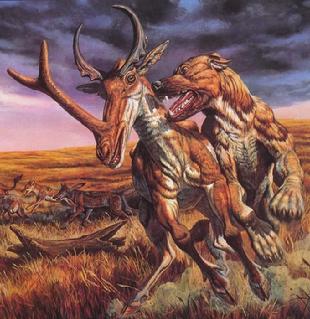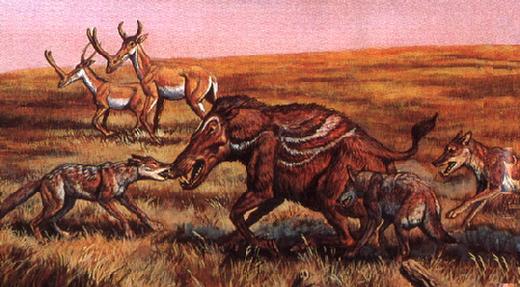| Should we really be feeding the wolf within? |
| The Origins of the Domestic Dog |
 |
| Epicyon - an earlier larger canine |
|
|
 |
| Eucyon - smaller canid from which wolves originated |
|
|
Epicyon and Eucyon
Epicyon (epp-ih-SIGH-on) was one of the larger, perhaps largest, of extinct canines that lived on the North American continent for over 15 million years. The name epicyon means "near dog". It was about 150lbs at adult weight, and while it was a true canid, its head resembled more of a large cat than that of a wolf. While a hunter, it has also been speculated that it lived almost entirely off of already dead animals or carcasses. As the larger animals of the time became extinct, so did epicyon.
It smaller competitor was eucyon (YOU-sigh-on) and also lived during the Late Miocene era. Its name is Greek for "original dog." Eucyon was only about three feet long or 25 pounds. It is thought that the modern canis genus (which encompasses dogs and wolves) came from Eucyon and may have lived for several million years together until eucyon fell extinct.
About 100,000 years ago, it is believed that dogs arose from wolves and were later domesticated about 14,000 years ago by early humans. This has largely been due to the study and research done by Dr Robert Wayne PhD, a geneticist from UCLA. His studies have evaluated the mitochondrial DNA of dogs, wolves, coyotes and jackals. Mitochondrial DNA is passed maternally.
Dogs are different than wolves.
With more than 100,000 years of being a separate species (135,000 years according to a Swedish study1), dogs have changed dramatically from wolves. With more than four distinct genetic groups throughout the world, it is believed that the dogs of today were individually domesticated be separate peoples throughout the world and do not have a common wild dog ancestor. We do know that the dogs are not evolved to jackals, coyotes or foxes due to DNA research.
"We expected to find DNA sequences in dogs that were closely related to those in wolves, perhaps even indistinguishable from those in wolves, we expexted to find few different sequences in dogs; instead we found 26." - Dr Robert Wayne, UCLA.
If dogs are omnivores, why are they part of the order Carnivora?
This is a good question and a fact cited often by those recommending overly high recommendations of protein or meat to be fed to dogs. Dogs are indeed a member of the order Carnivora. The order includes many animals based upon various structures including their carnassial teeth made of their last upper premolars and first set of lower molars. This order includes carnivores (eats other animals primarily), omnivores (eats both plants and animals as primary diet) and herbivores (eats primarily plants). A great example of a herbivore of the order Carnivora is the Panda Bear who can live off of a diet that is 99% bamboo.
So yes, dogs are omnivores and require much less protein than a cat. They can manufacture an amino acid that cats cannot and can live off of a diet that is as low as 8% protein (if the protein is highly digestible like egg) according to the NRC.
1) Vila C, Maldonando J E , Phylogenetic Relationships, Evolution and the Genetic Diversity of the Domestic Dog.
|
| Facultative Fantasies: "Aren't dogs faculative carnivores though?" |
Some companies try to "educate" you on their websites and food bags that dogs are "facultative carnivores." It sounds good doesn't it? It sounds even more knowledgeable than the antiquated omnivore or carnivore terms.
Unfortunately this term is just another slight of hand (or should I say "slight of phrase"), to sell you on the concept of high protein for your dog. As we know, when we look at protein amounts for your pet, the ideal amount covers the minimum that is needed with focus on bio-availability and biologic value while avoided excess which always must correlate with excess phosphorus.
So what is a facultative carnivore?
This excerpt is from wikipedia:
"Animals that depend solely on animal flesh for their nutrient requirements are considered obligate carnivores while those that also consume non-animal food are considered facultative carnivores. [2] . Omnivores also consume both animal and non-animal food, and apart from the more
general definition, there is no clearly defined ratio of plant to animal
material that would distinguish a facultative carnivore from an
omnivore, or an omnivore from a facultative herbivore, for that matter.[3]"
http://en.wikipedia.org/wiki/Facultative_carnivore#cite_note-MC-1
[2] - Mammals: Carnivores. Duane E. Ullrey. Encyclopedia of Animal Science.
[3] - Mammals: Omnivores. Duane E. Ullrey. Encyclopedia of Animal Science.
Thus a facultative carnivore is just an alternative term for omnivore. If current fads at some point turn away from high animal meat protein in pet foods we may start hearing that dogs are facultative herbivores.
The use of this term may be considered disturbing as it employes a vague term in the hopes of appearing knowledgeable. As always, to further evaluate the food we must return to the fundamentals of what we look for in determining food quality and appropriateness for our pet.
|
| Are all omnivores created equal? |
So if a my dog is an omnivore and I am an omnivore, then I can just feed my dog like I do myself right? Nope, of course not. Every species is a big different and their nutrients should not only be focused on their lifestage, lifestyle, disease status but also their species. One simple example is Vitamin C. Humans and guinea pigs cannot make ascorbic acid. Thus ascorbic acid is a classified as a vitamin and we call it vitamin C. For dogs and cats though, ascorbic acid is not essential because they can make it on their own. Thus to be accurate, we could refer to it as ascorbic acid and not as Vitamin C because in dogs and cats, it is not a vitamin.
We must closely look at quantities and ratios of amino acids, vitamins, minerals, fatty acids and carbohydrates in a species specific manner.
|
|